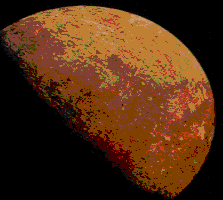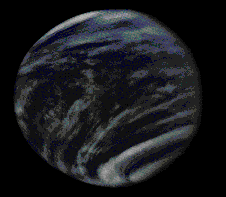
The Sun, our closest star. Observe the solar flare, it lasted 5 hours! The Sun is a typical main sequence star - its mass, size, surface temperature an composition lie roughly midway between the extremes exhibited by other stars. Diameter: 1,392,530 KM. Mass: 330,000 Earths. Surface temp: 5,800 Kelvin. Light time to Earth: 8.3 minutes.

Mercury, the first planet from the Sun. Mercury is hard to see from Earth because it is so small and so close to the sun. At certain times of the year, it can be seen just after sunset or before sunrise. The rest of the time it is lost in the sun's glare. Mean distance from Sun: 58,000,000 KM. Diameter: 4880 KM. Mass: 0.06 Earths. Orbital period: 88 days.

Venus, the second planet from the Sun and the brightest object in the sky, after the Sun and the Moon, is often visible for several hours just after sunset or before sunrise (hence it's name as the "Evening" or "Morning" star.) There are thick clouds covering the entire planet. Distance from Sun: 108,000,000 KM. Diameter: 12,100 KM. Mass: 0.95 Earths. Orbital period: 226 days.

This is our planet Earth. The third planet form the Sun. Distance from the Sun is 150,000,000 KM, it's diameter is 12,760 KM, mass = 6x10^23 Kgrams. Please recycle to keep it alive!!!

Our satellite the Moon. The Moon is the closest astronomical body to the Earth and we know more about it than any other object in the heavens. The Earth and Moon form a double-planet system. Mean distance from Earth: 384,400 KM, Diameter: 3476 KM Mass: 0.0123 Earths. Orbital period (Synodic): 29.53 days.

Mars is the fourth planet from the Sun. Mars appears reddish in our sky, even to the naked eye. This is caused by the rich content of rust (iron oxide) in the top soil. In the Martian springtime the surface of the planet changes color due to seasonal winds covering and uncovering darker surfaces of reddish dust. Mars has two small moons - Phobos is the larger and zips around Mars in only 7 1/2 hours. Deimos, the smaller moon, takes 30 hours to orbit. Distance from Sun: 228,000,000 KM. Diameter: 6,800 KM. Mass: 0.53 Earths. Orbital period: 686 days.

Jupiter is the fifth planet and the Solar System's largest planet - its composition is more like a star than a planet. Bright belts, changing cloud structures, four main moons (each larger thanEarth's satellite) and the Great Red Spot are all easily visible in small telescopes. Jupiter was recently visited by a probe call Galileo. Distance from Sun: 778,000,000 KM. Diameter: 143,800 KM. Mass: 317.89 Earths. Orbital period: 11 years, 321 days.

Saturn is perhaps the best known astronomical object by picture. The Sixth planet from the Sun. Its beauty in even small telescopes is breathtaking, and larger scopes reveal details in the delicate ring structure and colored bands in the outer layers of the atmosphere. The rings consist of billions of particles (probably water and methane ice) ranging from a few centimeters to a few meters in diameter. There are three major ring systems, separated by the Cassini division (outer) and the Encke division (inner). Distance from Sun: 1,427,000,000 KM. Diameter: 120,000 KM. Mass: 95.15 Earths. Orbital period: 29 years, 168 days.

Uranus the seventh planet from the Sun. Without the information gathered by Voyager 2, little would be known about this distant planet. Although visible in small to medium telescopes, not nuch is revealed by Earth-based observation other than Uranus' pale blue color. The planet is now know to have a system of at least nine rings. Mean distance from Sun: 2,870,000,000 KM. Diameter: 52,300 KM. Mass: 14.54 Earths. Orbital period: 84.01 years.

Neptune is eighth planet from the Sun. Similar in size and composition to Uranus, the eighth planet is so far from Earth that ground-based observations reveal little detail. Voyager 2 data confirm the presence of a tenuous ring system. Neptune's largest moon, Triton, may be glimpsed in telescopes of apertures of 30 cm. Mean distance from Sun: 4,497,000,000 KM. Diameter: 49,500 KM. Mass: 17.23 Earths. Orbital period: 164.79 years.

Pluto is the nineth planet from the Sun. Its long ears have help pluto to keep it within the orbit of the Sun. Its nose can smell bones all over the Solar System and beyond. Pluto is very playful, wuould you like to play with him?
Bueno eso es todo por ahora, ya los llevare de paseo a otros lugares. Ciao y suerte.
luigi
deas & comments click